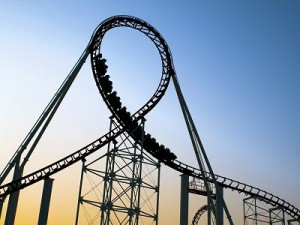[am4show have='p8;p9;p11;p38;p72;p77;p92;' guest_error='Guest error message' user_error='User error message' ]This section of physics covers both the physics of sound and motion, so you'll not only find the best parent-annoyer noisemakers here, but also how to build an indoor 70- long roller coaster!This also means that you'll find two videos on this page: one for Sound, and the second one is for Roller Coasters. After you finished one video (or both), simply click over to the experiments and get started.
Physics of Sound
 Sound is everywhere. It can travel through solids, liquids, and gases, but it does so at different speeds. It can rustle through trees at 770 MPH (miles per hour), echo through the ocean at 3,270 MPH, and resonate through solid rock at 8,600 MPH.
Sound is everywhere. It can travel through solids, liquids, and gases, but it does so at different speeds. It can rustle through trees at 770 MPH (miles per hour), echo through the ocean at 3,270 MPH, and resonate through solid rock at 8,600 MPH.
Sound is made by things vibrating back and forth, whether it's a guitar string, drum head, or clarinet. The back and forth motion of an object (like the drum head) creates a sound wave in the air that looks a lot like a ripple in a pond after you throw a rock in. It radiates outward, vibrating it's neighboring air molecules until they are moving around, too.
This chain reaction keeps happening until it reaches your ears, where your "sound detectors" pick up the vibration and works with your brain to turn it into sound. Sound can change according to the speed at which it travels. (Another word for sound speed is pitch.)
When the sound speed slows, the pitch lowers. With clarinet reeds, it's high. Guitar strings can do both, as they are adjustable. If you look carefully, you can actually see the low pitch strings vibrate back and forth, but the high pitch strings move so quickly it's hard to see. But you can detect the effects of both with your ears.
Your voice is a vibration, and you can feel it when you place a hand on your throat when you speak. As long as there are molecules around, sound will be traveling though them by smacking into each other. That's why if you put an alarm clock inside a glass jar and remove the air, there's no sound from the clock. There's nothing to transfer the vibrational energy to – nothing to smack into to transfer the sound. It's like trying to grab hold of fog – there’s nothing to hold on to. Let's do some experiments to bring these concepts to life.
Physics of Motion: Roller Coasters
 Do you know the pancake feeling you get when your body moves in a fast circle? Whether it's in a car turn, roller coaster loop, or playground merry-g-round, you can feel the effect of acceleration. The reason why things bounce, fly, zoom, and splat are described by the Laws of Physical Motion most kids learn in their high school physics class. But you don't have to wait to have fun with physics – you can start right now!
Do you know the pancake feeling you get when your body moves in a fast circle? Whether it's in a car turn, roller coaster loop, or playground merry-g-round, you can feel the effect of acceleration. The reason why things bounce, fly, zoom, and splat are described by the Laws of Physical Motion most kids learn in their high school physics class. But you don't have to wait to have fun with physics – you can start right now!
Kids across the globe use the law of gravitation everyday to put the zing in their games, from basketball to skateboarding. We're going to learn the reason water stays in the bucket when you swing it over your head and how rockets stay up in orbit. Physical motion is everywhere, challenging toddlers learning to walk as well as Olympic downhill skiers to go the distance. Let's find out how they do it.
Take a look at the first law of motion. When you place a ball on the floor, it stays put. No movement, motion, nada, zip.
This is the first law of motion: An object at rest tends to stay at rest… unless acted upon by an external force. Your foot is the external force… so kick it! An object in motion tends to stay in motion unless acted upon by an external force. After you kicked the ball (external force), it flies through the air until it smacks into something (another external force).
A roller coaster would continue forever in a straight line unless the track forces it into a loop. But there are two other forces that you can't see. One force is air resistance. A tossed ball smacks into air molecules when it flies through the air, and we call this effect drag. The other force is gravitational. Gravity is inherent in anything that has mass (including you!), but you need something the size of a planet before you can begin to see the effects it has on other objects. If you tossed your ball in space (away from any nearby gravitational pulls like black holes or galaxies), it would continue in a straight line forever. There aren't any molecules for it to collide with, and no gravitational effects to pull it off-course.
We're going to build a HUGE roller coaster in your house to help illustrate these ideas.
Do you know the pancake feeling you get when your body moves in a fast circle? Whether it's in a car turn, roller coaster loop, or playground merry-g-round, you can feel the effect of acceleration.
The reason why things bounce, fly, zoom, and splat are described by the Laws of Physical Motion most kids learn in their high school physics class. But you don't have to wait to have fun with physics – you can start right now! Kids across the globe use the law of gravitation everyday to put the zing in their games, from basketball to skateboarding.
We're going to learn the reason water stays in the bucket when you swing it over your head and how rockets stay up in orbit. Physical motion is everywhere, challenging toddlers learning to walk as well as Olympic downhill skiers to go the distance. Let's find out how they do it.
Take a look at the first law of motion. When you place a ball on the floor, it stays put. No movement, motion, nada, zip. This is the first law of motion: An object at rest tends to stay at rest… unless acted upon by an external force. Your foot is the external force… so kick it!
An object in motion tends to stay in motion unless acted upon by an external force. After you kicked the ball (external force), it flies through the air until it smacks into something (another external force).
A roller coaster would continue forever in a straight line unless the track forces it into a loop. But there are two other forces that you can't see. One force is air resistance. A tossed ball smacks into air molecules when it flies through the air, and we call this effect drag.
The other force is gravitational. Gravity is inherent in anything that has mass (including you!), but you need something the size of a planet before you can begin to see the effects it has on other objects. If you tossed your ball in space (away from any nearby gravitational pulls like black holes or galaxies), it would continue in a straight line forever. There aren't any molecules for it to collide with, and no gravitational effects to pull it off-course. We're going to build a HUGE roller coaster in your house to help illustrate these ideas.
[/am4show]
